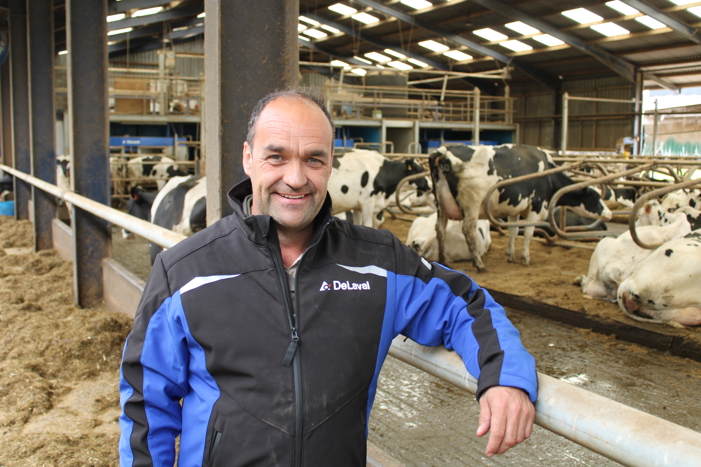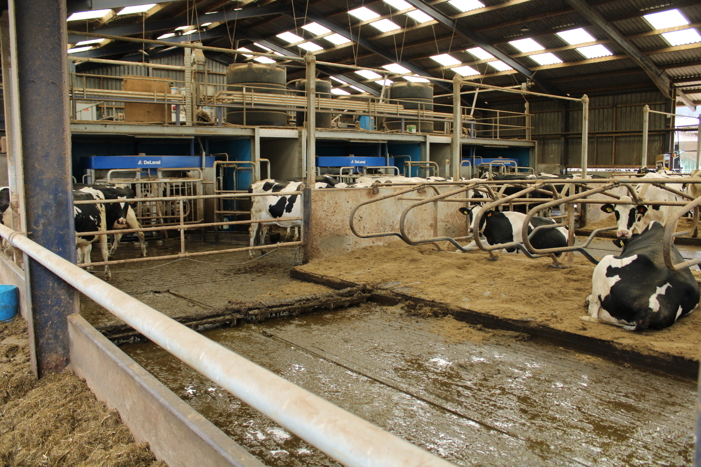Teat spray lowers bactoscan to drive farm productivity
Following an on-farm, six month trial of the new DeLaval Titan teat spray, Richard Threlfell has seen his bactoscan results reduce to single figures, which has brought a financial bonus from his milk buyer and has improved cow health.

Mr Threlfell milks 344 cows through four DeLaval VMS robots at Plumpton Head Farm in Cumbria. The robots were installed in November 2020 but, even with year on year reductions in bactoscan tests, he wanted to see if the new teat spray could help further.
“I was approached by DeLaval and was naturally sceptical that a teat spray could provide such significant improvements, but I was willing to give it a go. Our bactoscans were okay but I was conscious that they could have been better, so began using the product in January 2025,” he says.
The result has seen his bactoscans drop as low as 9 and rarely go above 25. Titan is administered by the robot after milking and leaves each teat with a yellow film, protective layer which helps to protect against environmental pathogens like S. uberis and E. coli which are prevalent causes of mastitis.
“Our mastitis cases have been very low, especially since we installed the robots, but with the hot weather we have been concerned about cases rising. Thankfully, Titan has come at an opportune time because we are having one of the hottest years on record and yet our mastitis cases are at an all time low,” he says.
Six months of using Titan has seen the farm receive a 0.5p per litre bonus from its milk buyer. Prior to the trial in May 2024, the farm was losing the equivalent of 0.5p per litre because bactoscans were too high.

“Using Titan has really turned things around and we have gone from a significant deficit to a situation where we are instead receiving a bonus. We haven’t had to make any changes to the robots. There are two nozzles to administer a pre and post dip to udders and we have added Titan as the post dip,” he says.
The farm has made improvements to dry cow management, making sure that every cow is given 60 days to dry off and is brought in 21 days before calving to receive an enriched TMR.
“We are getting cows back in calf between 60 and 100 days. We have had cows suffer from endometritis in the past, which we linked to mastitis problems. It meant we would sometimes have to serve four or five times, but this year it hasn’t been a problem so we are saving money on AI too,” he says.
He suggests that getting the dry period right, and having cows coming to dry off with healthy teats, has reduced mastitis and milk fever.
“We have made other changes including a calcium bolus, a dry cow blend and a high dry matter diet that includes straw to help to get the rumen working and keep cows full,” he adds.
He has also put aside 60 acres of pasture where slurry is not applied when dry cows are grazing.
“All these little changes have added up to make the drying off process more efficient and better for the cows,” he says.
The knock-on effect to the herd is that cows are staying in milk longer and are staying in the herd longer.
“We have a new income selling in-calf heifers because we don’t need them ourselves. About 10 percent of the herd have been milked for 9 years or longer, which is a testament to cow health and longevity,” he says.
To improve air flow and reduce moisture he has added six fans to the shed, which has also seen the herd space out more evenly.
“We would see cows gathering in the cooler areas of the shed, which wasn’t ideal. The fans have made a big difference, and the cows seem calmer and happier even in the hot weather we have had this year,” he says.
Following the improvements made to the farm system, he sees ongoing cow health management as paramount to milking productivity.
“We have invested in the best technology to milk and monitor the cows, and housed it in a new shed that provides the cows with an environment that has seen the herd be at its most productive. However, seemingly small additions like Titan have shown us that there are always ways that we can further improve cow welfare and optimise our milk production,” he concludes.